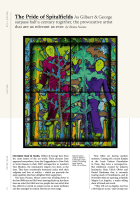AS GILBERT & GEORGE SURPASS HALF A CENTURY TOGETHER, THE PROVOCATIVE ARTIST DUO ARE AS BRAZEN AND RELEVANT AS EVER
For more than 50 years, Gilbert & George have been the court jesters of the art world. Their pictures have appeared everywhere, from the Guggenheim in New York to Soviet Russia to their 2007 retrospective at London’s Tate Modern, the institution’s largest ever show at the time. They have consistently frustrated critics with their vulgarity and love of artifice – which are precisely the same qualities that have delighted their supporters.
Not since Picasso, whose career was winding down in the late 1960s just as G&G were starting theirs up, has there been an artist (for G&G are two people but one artist) that has offered so varied an output across so many mediums and has managed to remain relevant at every stage.
Now G&G are having another moment. Coming off a recent display at the Louis Vuitton Foundation in Paris, they have a retrospective-like exhibition curated by industry luminaries Hans Ulrich Obrist and Daniel Birnbaum which is currently touring much of Scandinavia, and in November they are opening, at Sprüth Magers Los Angeles, a major selling show of brand new work.
“They tell us Los Angeles now has a thriving art scene,” says George one September morning with characteristic understatement. G&G don’t, as a rule, travel much farther than their feet can take them from their East London townhouse. They take no holidays, except to open their own exhibitions, and even going to the West End of the metropolis is considered an event. So the state of the global art market is something they can plausibly deny knowledge about – though, of course, Los Angeles is the hottest global city right now for art, and it is no coincidence G&G are taking their work there.
The pair have had success in the US, despite the sometimes awkward cultural fit with their profane and graphic works, but still they seem a touch nervous about the upcoming exhibition. “We haven’t shown in Los Angeles in 20 years,” says Gilbert. “Last time we were there,” continues George, “we didn’t sell a single picture. Not one. People simply didn’t go into the gallery.”
As outsider artists, G&G have no peers. They define the genre, or at any rate they have tried very hard to do so. At every point in their career they have pivoted to avoid a simple label or clear explanation: during their early years, for instance, they began by calling themselves sculptors but not making traditional art objects, merely photographic records of their performances. And then it was their lack of traditional heterosexual values. And then it was their profanity. And then their nudity. And then their right-wing political stances, especially in favour of Margaret Thatcher. And then it was their pitched battles with critics and institutions, which they believed never gave them enough respect.
It has rarely been clear just how serious any of their public statements are – whether they are continuous performances of the G&G brand or the genuine opinions of two men who simply have no taste for the prevailing norms. This kind of ambiguity tends to provoke ire nowadays among some Britons of a certain age, those who have followed the pair’s exploits for decades and have grown tired of this unceasing, deliberate provocation.
But seen from a wider lens, G&G are rarely, if ever, wantonly provocative. Their subjects are generally so immense and wide-ranging – death, love, sex, taboo – that any treatment is bound to be superficial. So rather than mere enfants terribles, they seem, as they approach their dotage, more like Samuel Beckett, stubbornly probing the mysteries of expression and existence in search of a goal they know they cannot reach.
At their Los Angeles show, called Paradisical Pictures, there are heavy themes ranging from mortality to waste in the floods of aggressively dying flowers, the faintly menacing leaves and the more-obscene-than-they-should-be dates and date pits, which interact, with the duo’s usual squirrelly, syncopated aesthetic rhythms, to give the impression of G&G themselves being chewed up and spit out.
Their individual pieces – which generally sell well, but still below prices one might expect of artists of their stature – aim to reach beyond the traditional, well-educated audience for fine art. “Art changes the world,” G&G have affirmed consistently over the decades, and this is one of their few claims that can only be taken earnestly – because they have proved their dedication with their actions.
Based in the Spitalfields neighbourhood of London for their entire career, they have acknowledged their local celebrity without embracing it. They do not venture into the houses of their neighbours for fear of obligation, just as they very rarely go to see any other artists’ works to avoid similar commitments. They are incredibly protective of this untarnished worldview, which they say is key to making their art. They have, for instance, just a single studio assistant, who they appreciate for his discretion: “If we had someone else,” George explains, “he might say ‘I really like that purple’ and then of course we’d either never use that purple again – or we’d use it in everything”.
A few minutes’ walk from their home, G&G are constructing a museum for their own work, an expansive space where they can “live forever” which will feature three large galleries and a small garden. George jokes that the pub next door, The Pride of Spitalfields, will have to change its name to The Shame of Spitalfields given its proximity to their provocative works. But of course that’s not true; if it’s smart the pub will change its name to The Gilbert & George and revel in the publicity.